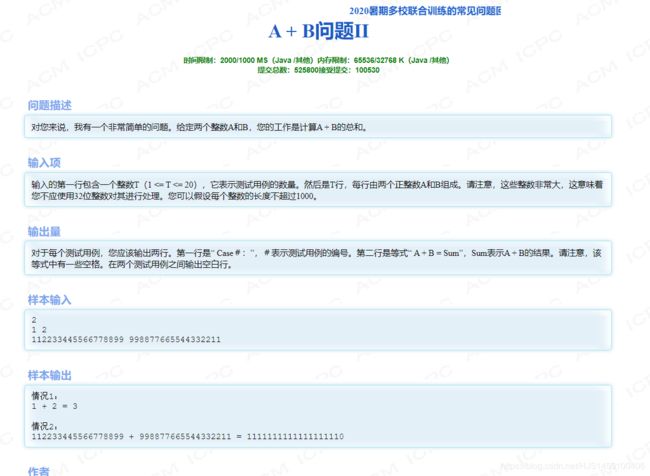杭电1002——A + B Problem II(大数问题)(Java实现)
Time Limit: 2000/1000 MS (Java/Others) Memory Limit: 65536/32768 K (Java/Others) Total Submission(s): 525800 Accepted Submission(s): 100530
Problem Description
I have a very simple problem for you. Given two integers A and B, your job is to calculate the Sum of A + B.
Input
The first line of the input contains an integer T(1<=T<=20) which means the number of test cases. Then T lines follow, each line consists of two positive integers, A and B. Notice that the integers are very large, that means you should not process them by using 32-bit integer. You may assume the length of each integer will not exceed 1000.
Output
For each test case, you should output two lines. The first line is “Case #:”, # means the number of the test case. The second line is the an equation “A + B = Sum”, Sum means the result of A + B. Note there are some spaces int the equation. Output a blank line between two test cases.
Sample Input
2
1 2
112233445566778899 998877665544332211
Sample Output
Case 1:
1 + 2 = 3
Case 2:
112233445566778899 + 998877665544332211 = 1111111111111111110

解析:
这道题主要考察的是对大数基本的处理,如果使用Java来实现,思路有两种;
第一种:使用数组处理;
思路:
1.用两个String类的对象接收数据;
2.定义两个远大于最大字符串长度的数组,用来存储字符串中的元素;
3.初始化字符串,将所有空间赋值为0(因为相加的两个大数长度不一定相同)
4.将两个字符串中的元素取出一一放入两个数组中(倒叙存放,从低位开始);
5.相加两个序号对应的数组元素,>=10进位
import java.util.Scanner;
public class Main {
public static void main(String [] args){
Scanner sc=new Scanner(System.in);
while(sc.hasNext()){
int M=sc.nextInt();
for (int i = 0; i <M ; i++) {
String s1=sc.next();
String s2=sc.next();
//注意!!!!!
// System.out.printf("Case %d:\n",i+1);
// System.out.println(s1+" + "+s2+" = "+sum(s1,s2));
System.out.println("Case "+(i+1)+":");
System.out.println(s1+" + "+s2+" = "+sum(s1,s2));
if (i<M-1)System.out.println();
}
}
}
public static String sum(String a,String b){
int a_len=a.length();
int b_len=b.length();
int Max=a_len>b_len ? a_len:b_len;
int [] S1=new int[Max+10];
int [] S2=new int[Max+10];
for (int i = 0; i <Max ; i++) {
S1[i]=0;
S2[i]=0;
}
int j=0;//定义一个计数器
for (int i = a_len-1; i >=0; i--) {//因为要从低位开始计算,所以从后往前
//S1[j]=a.charAt(i)-48;
//j++;
S1[j++]=a.charAt(i)-48;//简化
}
j=0;
for (int i = b_len-1; i >=0; i--) {
S2[j++]=b.charAt(i)-48;
}
for (int i = 0; i <Max; i++) {
S1[i]+=S2[i];
if (S1[i]>=10) {S1[i]-=10;S1[i+1]++;}
}
String str="";
boolean F=false;
for (int i = Max; i >=0 ; i--) {
if(S1[i]!=0) F=true;//去除多余的0,如果F==true代表遇到了非零元素,可以开始计算了
if (F) str+=S1[i];
if(i==0 && !F) str+=0;//0比较特殊,需要单独写出;
}
return str;
}
}
特别注意的点!!
注意我在这个代码中注释“注意!!!!”下方的输出格式,如果是以这样的格式输出,在杭电的oj上会报格式异常的错误;

其实不是我们做错了,而是因为。。。。。。。
第二种:使用Java中自带的BigInteger;
思路:Java中自带的类BigInteger就是用来处理大数的,所以直接用就行,好玩不烫手~~
import java.util.Scanner;
import java.math.*;
public class Main {
public static void main(String[] args) {
Scanner sc = new Scanner(System.in);
int n = sc.nextInt();
int count = 1;
while(n>0)
{
if(count!=1)
System.out.println();
BigInteger a = sc.nextBigInteger();
BigInteger b = sc.nextBigInteger();
System.out.println("Case "+count+":");
System.out.println(a+" + "+b+" = "+a.add(b));
count++;
n--;
}
}
}
最后总结一下:在学习中遇到过很多的坑,有自己的错也有平台的问题;但是我觉得不管是哪一类都不必顾虑太多,踩的坑多了才会成长吧,起码我是这么认为的;
再者说,无论是自己还是平台,都是人性的,不可能十全十美,也正是因为这样,编程才好玩,世界才有趣~
Over~
